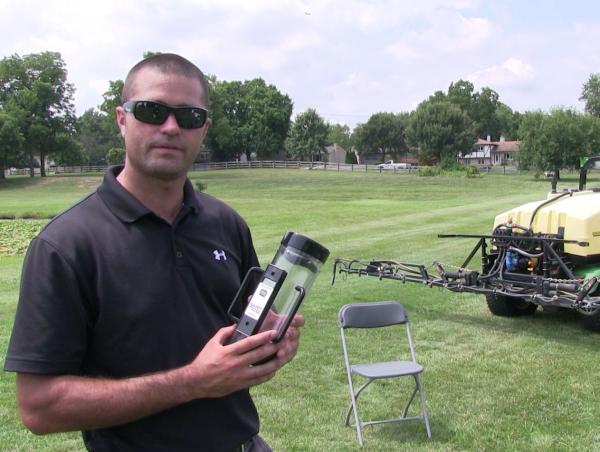Getting the most from a spray program depends largely on getting the most out of a sprayer, and that means accurate calibration. But calibrating a sprayer is something most spray applicators don't do nearly often enough, says Zane Raudenbush, Ph.D., of Ohio State Agricultural Technical Institute, who began teaching sprayer calibration during his days at Kansas State University.
 "I have been teaching sprayer calibration while studying for my master's and Ph.D., and now at ATI, and I have taught it a couple of different ways," said Raudenbush, turfgrass management program coordinator for ATI in Wooster. "There are a lot of opportunities for errors. From what I've seen, it's something that people struggle with."
"I have been teaching sprayer calibration while studying for my master's and Ph.D., and now at ATI, and I have taught it a couple of different ways," said Raudenbush, turfgrass management program coordinator for ATI in Wooster. "There are a lot of opportunities for errors. From what I've seen, it's something that people struggle with."Calibrating a sprayer to ensure an efficient and accurate spray application is not that difficult, Raudenbush said during the recent Ohio Turfgrass Foundation Turf Research Field Day.
According to Raudenbush there are three key steps in sprayer calibration: sprayer speed in mph, gallons per minute and nozzle selection/spacing.
"When calibrating a sprayer, the place I start is ground speed," Raudenbush said. "If you're on a golf course and spraying fairways, you don't want to travel 2 miles per hour, or you'll be out there all day. Pick a speed for your sprayer speed that can be repeated every time, allows operators to work in a safe manner and gives you good coverage. You know what your staff is capable of. I made that mistake of picking a wrong sprayer speed, filled the sprayer and the 11th hole was so steep the sprayer couldn't pull itself up the hill."
Drift, non-target movement and wasting product are big concerns any time a spray unit is fired up, says Raudenbush. Managing any one of the three factors mentioned above, speed, gpm and spacing, can greatly influence spray volume, as can spray unit pressure, for which, he said, the industry standard is 40 psi.
"You can change speed, but that is one I leave alone," Raudenbush said. "Next would be psi, but that is for fine tuning, not to change spray volume. The easiest way to change spray volume is to change out the nozzles."
During a demonstration at the OSU field day, Raudenbush had a sprayer outfitted with four different TeeJet nozzles: 8001, 8002, 8003 and 8004, which deliver at 0.1 gpm, 0.2 gpm, 0.3 gpm and 0.4 gpm, respectively.
If the operator keeps keep everything else constant, spray volume can be cut in half just by changing nozzles from an 8004 to an 8002.
Changing pressure and nozzle size also will influence droplet size, which can affect drift. More pressure and a smaller nozzle orifice result in finer droplet size, increasing the chance for movement. Raudenbush suggests using water-sensitive paper (available through most nozzle vendors) to check droplet size and coverage.
A rule of thumb is that nozzle spacing should be the same as the distance from the spray boom to the turf surface to ensure proper coverage.
Other ways to check nozzle accuracy include the catch-can test, but Raudenbush prefers using a SpotOn sprayer calibrator from Innoquest Inc. Models range in price from $150-$219 and measure flow rate and wear in each nozzle by determining how long it takes water passing through the nozzle to reach a series of electrodes.
"If you don't like the droplet size or coverage, confirm when you go to spray what volume is and check spacing and angles," he said.
"The catch-can test can take some time. With the flow meters you don't need a second person or a stopwatch. That's why I like to use these.
"A lot of times, things get loose and you start to see where nozzle patterns will collide with each other, and that's where you can get some streaking taking place."

